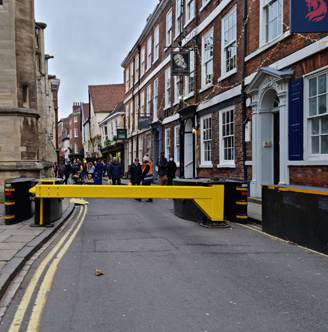The UK official Centre for the Protection of National Infrastructure (CPNI) has published the third edition of its guide on designing public spaces with consideration to HVM – Public Realm Design Guide Hostile Vehicle Mitigation.
The document starts with the context – the methods used by terrorists, and how ‘every metre counts’ in what can be busy and restricted urban spaces. You then go on to risk assessment; and the role of design, in traffic management and in reducing its speed, while allowing access (including for cyclists, and people on foot).
The document goes through the ‘five Cs’ of capacity, comfort, convenience, conflict and context. Briefly, capacity is ‘the maximum flow rate at which pedestrians can safely flow through a space’, in a set time. Comfort is the personal space for pedestrians, so that they may move freely, as measured in people per square metre. If in a queue or standing still, higher densities may be felt as comfortable. Convenience is defined ‘as the ability of a pedestrian to identify and follow their preferred to their target at their favoured speed’. Conflict is an event that interrupts that pedestrian’s movement, whether a pedestrian meets a bollard or two or more pedestrians collide.
And context is what may affect a pedestrian’s behaviours or choice of route – such as, if those around are elderly, or drunk, or are unfamiliar with a site and looking at wayfinding signs, or are with prams or luggage, or if the lighting is poor after dark.
The document covers scenarios for the designer; and how they might use HVM such as bollards.
It’s aimed at designers, their clients, local government officers, venue managers and operators that are involved with the safety of the public realm and Publicly Accessible Locations (PALs), to use the term that’s replacing ‘crowded places’.
Given attacks in the UK and overseas in recent years that attacks used ‘vehicles as a weapon’, many towns and cities now deploy security barriers to physically deter and prevent such attacks (picture by Mark Rowe, historic shopping street in York, last year); but there are other options, CPNI says. The guide is endorsed by the Royal Institute of British Architects (RIBA), Royal Town Planning Institute (RTPI), Department of Transport, Mayor of London, Transport for London, National Counter Terrorism Security Office, Landscape Institute, British Property Federation and The Crown Estate.
CPNI’s Head of Physical Security said: “We are grateful for the input of all the professionals who helped us update this important Guide. Since CPNI produced an Integrated Security Guide over a decade ago, attacks using vehicles have been on the rise around the world. Through this ‘Public Realm Design Guide for Hostile Vehicle Mitigation’, supported by a comprehensive programme of research, development and testing, CPNI are providing the design professions with a palette of measures and the necessary awareness, knowledge and tools to help keep the public safe. This Guide shows how safety and security can go hand in hand with aesthetics and appealing, multi-purpose design solutions.”
You can view the 106-page document on the CPNI website.









